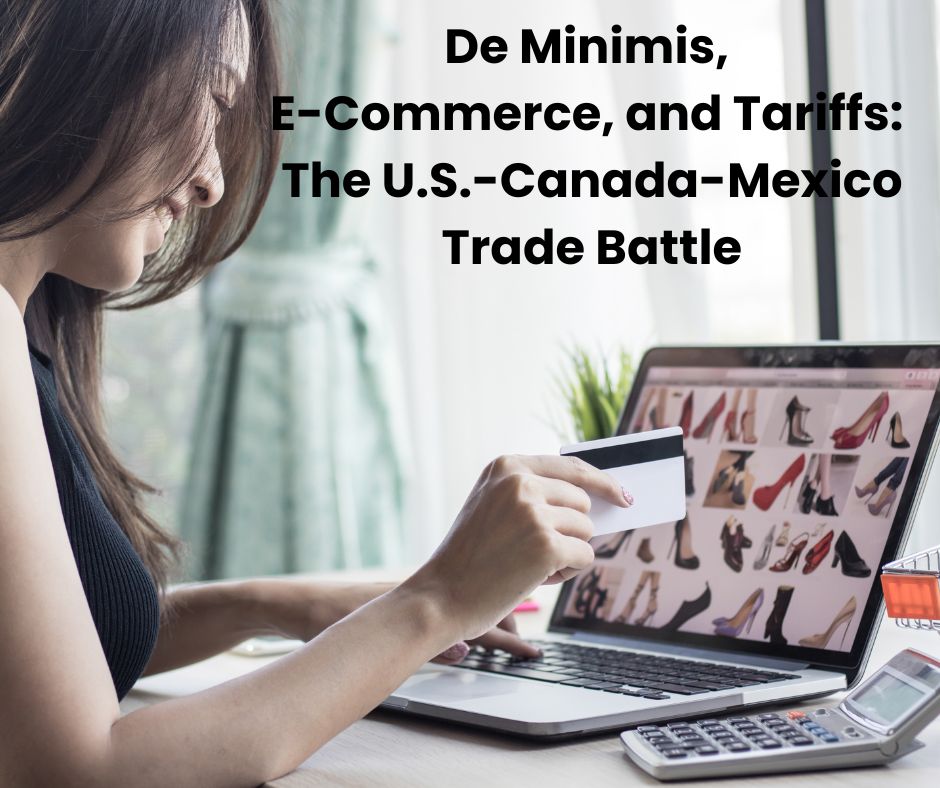De Minimis, E-Commerce, and Tariffs: The U.S.-Canada-Mexico Trade Battle

The ongoing trade tensions between the U.S., Canada, and Mexico have now expanded beyond traditional tariffs to include e-commerce and de minimis thresholds. With the U.S. recently imposing a 10% tariff on imports from China and 25% tariff on imports from Canada and Mexico, the impact on cross-border online shopping has intensified, raising new challenges for retailers, consumers, and policymakers.
What is De Minimis and Why Does It Matter?
The de minimis threshold is the maximum value an imported product can have before it faces duties and taxes. It plays a huge role in e-commerce, as it determines how easy and cost-effective it is for consumers to buy products from another country online.
Current De Minimis Thresholds in North America:
· United States: $800 USD – The highest in the region, allowing consumers to buy duty-free goods from abroad up to this amount.
· Canada: $40 CAD (about $30 USD) for taxes, $150 CAD for duties under USMCA for goods from Mexico and United States – One of the lowest globally, making most imports subject to taxes.
· Mexico: $50 USD for taxes, $117 USD for duties under USMCA for goods from Canada and United States – Higher than Canada’s but still much lower than the U.S.
How the 25% Tariff Changes the Game
The new 10% tariff on certain Chinese and other foreign imports into the U.S. has direct and indirect effects on de minimis shipments:
1. Higher Costs for U.S. Retailers and Consumers
Many low-cost consumer goods, such as electronics, clothing, and household items, are manufactured in China and sold in the U.S. under de minimis rules. With a 10% 25% tariff, U.S. retailers importing these goods face higher costs, which will likely be passed on to consumers.
· NOTE: The 10% tariff is an additional duty imposed on the General (MFN) rate and the section 301 duty (listed in Ch. 99 HTSUS). These tariffs are cumulative.
2. E-Commerce Arbitrage: Advantage Canada & Mexico?
Since Canadian and Mexican e-commerce platforms source many of the same products, they might avoid the multiple tariffs imposed on Chinese goods 25% tariff when selling domestically. This could create a situation where U.S. consumers look to Canadian and Mexican sellers for cheaper alternatives—if the order stays under $800 USD (the U.S. de minimis threshold).
This cross-border loophole could see more American consumers ordering from Canadian and Mexican retailers, ironically benefiting the very trade partners the U.S. tariffs were meant to hurt.
3. Canada and Mexico Push for De Minimis Reform
With a flood of U.S. e-commerce goods entering Canada and Mexico duty-free, both countries have long argued that the U.S. de minimis threshold is too high. Now, with 25% tariffs making U.S. goods more expensive, Canadian and Mexican businesses see an opportunity to demand lower U.S. de minimis limits to reduce unfair competition.
4. Retaliation? Higher Duties on U.S. Goods
In response, Canada and Mexico could impose stricter enforcement or increase tariffs on U.S. e-commerce shipments, closing off the trade loophole and forcing American businesses to rethink their supply chains.
Bigger Picture: The Trade War Moves Online
This isn’t just about tariffs anymore—it’s about how trade wars are shifting into the digital economy. Traditional conflicts were focused on steel, agriculture, and manufacturing, but now, e-commerce regulations, de minimis rules, and digital trade policies are at the heart of North America’s economic tensions, especially since the U.S. has announced that it would not comply with OECD Pillar II imposing a minimum global tax on multi-national corporations leading some nations to re-impose their Digital Services Tax on U.S. technology companies.
With growing political pressure, consumer backlash, and retailer lobbying, the de minimis loophole and 25% tariffs could become a major flashpoint in upcoming U.S.-Canada-Mexico trade negotiations.
What Comes Next? Possible Scenarios
1. Canada and Mexico Lower Their De Minimis Thresholds to restrict American sellers from flooding their markets.
2. The U.S. Lowers Its Own De Minimis Limit, making it harder for Americans to buy tax-free from Canada and Mexico.
3. New Retaliatory Tariffs on U.S. E-Commerce Goods, increasing costs for American retailers selling abroad.
4. A Policy Stalemate, where the loophole remains, and businesses adjust supply chains accordingly.
Regardless of the outcome, one thing is clear: trade wars are no longer just about tariffs—they're about the future of online shopping, digital trade, and economic power in North America.